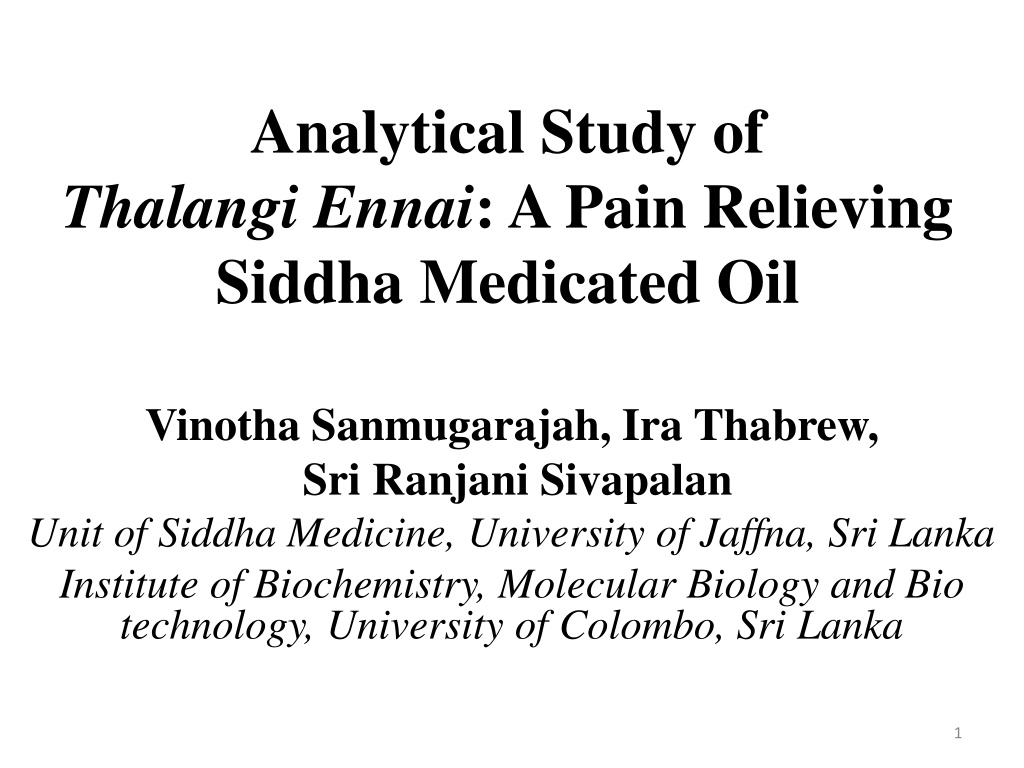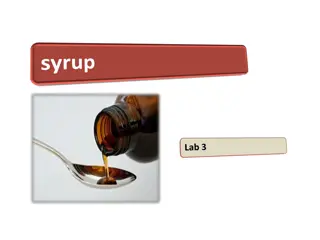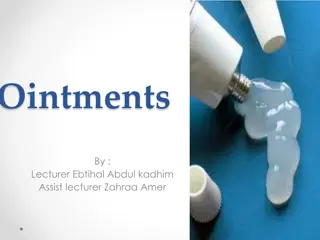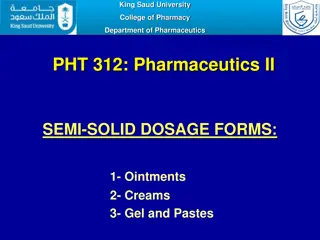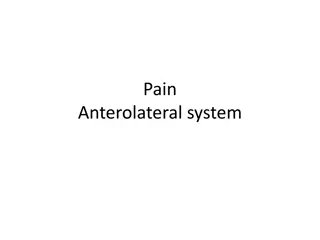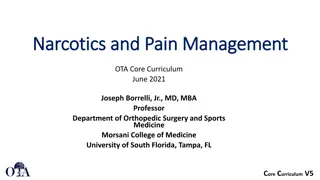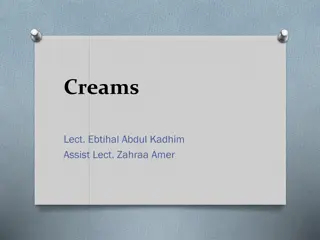Analytical Study of Thalangi Ennai: A Pain Relieving Siddha Medicated Oil
Siddha, Ayurveda, and Unani are the major traditional systems of medicine in Sri Lanka, with Siddha focusing on therapeutic practices. Thalangai ennai, a Siddha medicated oil, is clinically proven to provide pain relief properties. This oil is prepared at the Siddha Drug Unit in Jaffna and distributed to various healthcare facilities. The Siddha system of medicine has a rich history attributed to great scientists known as Siddhars. Siddha Materia Medica comprises resources from herbal, metal, and animal kingdoms, with various dosage forms for internal and external applications. Effective management of musculoskeletal disorders, such as rheumatic pain, is a key focus area for Siddha practitioners. The study of Thalangi Ennai's properties is essential for its standardization and further medical application.
Download Presentation

Please find below an Image/Link to download the presentation.
The content on the website is provided AS IS for your information and personal use only. It may not be sold, licensed, or shared on other websites without obtaining consent from the author. Download presentation by click this link. If you encounter any issues during the download, it is possible that the publisher has removed the file from their server.
E N D
Presentation Transcript
Analytical Study of Thalangi Ennai: A Pain Relieving Siddha Medicated Oil Vinotha Sanmugarajah, Ira Thabrew, Sri Ranjani Sivapalan Unit of Siddha Medicine, University of Jaffna, Sri Lanka Institute of Biochemistry, Molecular Biology and Bio technology, University of Colombo, Sri Lanka 1
Introduction Siddha, Ayurveda and Unani are the three major Traditional Systems of Medicine in Sri Lanka. Siddha which is largely therapeutic in nature has a rich heritage and history. The word Siddha means Perfection and those who attained perfection were known as Siddhars the pioneers of the system. 2
The Siddhars were great scientists in ancient times. Siddha is widely practiced in the Tamil speaking areas of Northern and Eastern provinces. According to tradition, the origin of Siddha system of Medicine is attributed to the great Siddha Agastiyar. Some of his works are still standard books of Medicine and surgery in daily use among the Siddha Medical practitioners and Traditional healers. 3
Siddha Materia Medica The resources of Siddha Materia Medica are classified in to three major divisions namely, Herbal Metals and Mineral Animal kingdoms According to Siddha literatures, there are 64 dosage forms of which 32 are meant for oral (internal) route and 32 for parental & external (including topical) applications. 4
Effective management of vt disorders such as rheumatic pain, bone degenerative changes and impaired movement of limbs are the important tasks in the field of treatment. Siddhars described v t disorders of different origin and external application is most useful for their management. Among them Ennai (Medicated oil) is one of the medicaments prescribed by them. 5
Thalangai ennai is one of the Siddha medicated oil mentioned in the Siddha Pharmacopeia and it is prepared at Siddha Drug Unit in Jaffna and supplied to all Government District Ayurvedic Hospital, Rural Ayurvedic Hospitals and Dispensaries in Jaffna District. Central Ayurvedic This oil is showing clinically enhanced pain relieving properties which requires analytical study for standardization. 6
Botanically pure and authentic ingredients were used in the preparation of T. ennai. Ingredients It is a compound medicine and its ingredients are, Juice of the thalangai (Pandanus tectorius) -1250 ml Sesame oil - 625 ml Cow s milk - 625 ml Water - 16000 ml Rock salt -10 g Seventeen different herbal raw materials - each 10 g 7
Details of ingredients of Thalangai ennai No Local name Scientific name Family name Pharmacological action Analgesic Potency 1 Nannari ver Asclepiadaceae Cold Hemidesmus indicus Plectranthus zeylanicus Andropogon muricatus Pavonia zeylanica 2 Villamichu ver Vetti ver Labiatae Refrigent Cold 3 Gramineae Stimulant Refrigent Analgesic Cold 4 Sittamutti Malvaceae Cold 5 6 Peramutti ver Pavonia odorata Malvaceae Tevadaru Cedrus deodara Analgesic Anti inflammatory Aromatic Cold Hot Coniferae 7 Jatamashi Velerianaceae Hot Nardostachys jatamansi kaempferia galanga Coscinum fenestratum 8 Kacholum Zingiberaceae Aromatic Stimulant Hot 9 Mara manjal Menispermaceae Analgesic Hot and Cold Aromatic 8
10 Sandanam 11 Kottam 12 Kundurukkan Boswellia serrata 13 Adi-maduram Glycyrrhizae glabra Santalaceae Scitaminaceae Burseraceae Papilionaceae Analgesic Stimulant Stimulant Emmolient Analgesic Deobstruent Stimulant Stimulant Aromatic Stimulant Aromatic Stimulant Cold Hot Hot Cold Santalum album Costus speciosus 14 Satakuppi Peucedanum graveolens Eletteria cardamomum Zanthochymus piotorlins Cyperus rotundus Umbelliferae Hot 15 Chirttilam/ elakaya 16 Patchchilai Zingiberaceae Hot Hot 17 Korai- kizangu 18 Thazhai/ thazaai Cyperaceae Cold Pandanaceae (Mudu- keyiya) Refrigent Aromatic Antispasmodic Stimulant Analgesic Cold Pandanus tectorius (Screw pine/ umbrella tree: Ketaki/ ketaka) NaCl impura Sesamum indicum 19 Rock salt 20 Sesame oil Hot Hot Pedaliaceae 21 Cow s milk Bos indicus inn 22 Water 9
Preparation Method of T. ennai From 1 to 17 dried raw materials are ground to get coarse powder and mixed with water. Then continued boiling to reduce the volume to one eighth (2000 ml). Juice of the thalangai, sesame oil, milk (2:1:1) are taken in a vessel and heated for some time; mixed the aqueous decoction together. This mixture is boiled on mild fire with stirring and boiling continued till all the water evaporates and this mixture turn as oily (waxy like). After cooled 10 minutes, the powdered rock salt mixed with the oil. 10
Objective The aim of this study was to evaluate the scientific validation of the Thalangai ennai. 11
Methodology For the Physicochemical analysis such as pH value, specific gravity and organoleptic characters such as colour, odour, appearance, touch and clarity were performed. scientific validation of this oil, Thin Layer Chromatography (TLC) finger print of the Thalangai ennai was studied after dissolved the oil in water and extracted with dichloromethane. The oil sample was purchased from Siddha Drug Unit, Atchuvely, Jaffna. 12
Physicochemical evaluation Sample of oil (Thalangai ennai) were subjected for determination of physicochemical parameters such as organoleptic characters, pH value and specific gravity. Organoleptic evalution These refer to macroscopic identification of the formulation. Sample of oil (Thalangai ennai), water and dichoromethane extracts of oil were subjected to the organoleptic characterization such as appearance, touch, colour, clarity and odour. 13
Determination of pH range The pH of sample of oil (Thalangai ennai) was determined using standard simple glass electrode pH meter (Consort). The oil was weighed to about 40ml in separate beaker and the pH of the oil was determined using a pH meter at room temperature (29 0C). 14
Determination ofspecific gravity (http://www.engineeringcivil.com) Clean, dry and weighed the specific gravity bottle along with the stopper (Weight A ). Then filled the specific gravity bottle with freshly distilled water and inserted the stopper firmly. Kept it in a room temperature and weighed it (Weight B ). Finally, filled the specific gravity bottle with the oil sample and weighed separately (Weight C ). Specific gravity (oil) = (C A) (B A) 15
Development of TLC fingerprints and standardization of thalangai ennai TLC finger print of the T.ennai was studied after dissolving the oil in water and extracted with dichloromethane. Prior dichloromethane extract of the oil to examined, used a rapid extraction process, as followed. to testing, prepared a water and Place about 50 ml thalangai ennai and fume ships of in an accurately weighed, glass-stoppered round bottom flask. 16
For the water extraction, 20 ml water was added to the flask and weighed to obtain the total weight including the flask. Then extraction was done by using reflux condenser for 2hours on heating mantle (Electro thermal). Then cooled and transferred to the Separator funnel system. After 20 minutes, the water extract was separated in to the clean small flask and kept tightly closed with lid. Further 20 ml water added to the residue in the round bottom flask and water extraction was done again as the same procedure. 17
After that, the whole separated water extract (30 ml) transferred in to the separator funnel system. Then 10 ml dichloromethane added to the water extract and mixed well. After 20 minutes, the dichloromethane extract was separated in to the accurately weighed, small round bottom flask and kept tightly closed with lid. Further 10 ml dichloromethane added to the residue in the separator funnel system and dichloromethane extract was separated again as the same procedure. 18
Then this procedure repeated again. Totally, dichloromethane extract separation was done for three times. Whole dichloromethane extract collected in to the round bottom flask and evaporated on a Rotary evaporator (Buchi) for just as long as was required to remove the solvent, and re-dissolved the residue in a small volume of dichloromethane (3 ml). Finally, the whole extract was collected in clean stoppered glass test tube and used for spotting the chromatographic plates. 19
Five l of oil extract was spotted on to TLC plates (8.5 x 5.3 cm) coated with silica gel (pre-coated, GF254) and separated using different solvent systems. After development visible spots were not found for oil extract. Numbers of spots were observed under UV light (254 & 366 nm). Visualization was attempted by spraying with vanillin sulphate reagent for oil extractand heating the plate for 5-10 minute (100-105 C). 20
The colour and Rf values of the spots were recorded carefully and the chromatogram was documented by graphical copying. (Rf value = The distance between the point of application and the centre of the spot of the material being examined / The distance between the point of application and the solvent front) 21
Results and Discussion The physicochemical standards available for the standardization of siddha oils are insufficient. The pharmacopoeia standards for siddha formulations are not finger print standards for each oil. analytical values available in the The first step towards this goal, Thalangai ennai was subjected to systematic physicochemical and Thin layer chromatography (TLC) analysis to determine the quality and purity of that oil. 22
Table No. 1: Analytical parameters of Thalangai Ennai Parameters Appearance Touch Colour Clarity Odour pH value (290C) Specific gravity Thalangai Ennai Viscous Oily Golden brown Clear Characteristic 4.61 0.9185 23
Table No.2: Organoleptic properties of the water and dichloromethane extracts of the Thalangai Ennai Parameters Water extract Appearance Liquid Touch Liquid Colour Light yellow Clarity Clear Odour Characteristic Thalangai Ennai Dichloromethane extract Liquid Liquid yellow Clear Characteristic 24
Thalangai Ennai of Government Siddha Drug Unit Dichloromethane extract of Thalangai ennai 25
According to Table 1, The results showed that this oil (T. ennai) contains specific gravity 0.9185 and pH value 4.61 at room temperature (290C). As seen in Table 2, both extracts of the oil (T. ennai) had similar organoleptic properties except for the colour of the water and dichloromethane extracts. 26
254 nm 366 nm Visible after spray TLC finger print analysis of extract of Thalangai Ennai 27
Table 3: TLC finger print analysis of extract of Thalangai Ennai Solvent system:- Pure Dichloromethane (volume) Solvent front:- 7 cm Rf values and colour of spots {*- intense, $- Moderately intense, #- Faint} 0.0286 * Brown 0.0571$ Pink 0.0714* Brown 0.1143# Grey 0.1857# Brown 0.2286$ Pink 0.2571$ Grey 0.3571# Pink 0.4000$ Pink 0.4428$ Green 0.5286# Pink 0.5857# Green 0.8571# Pink 0.9143* Orange 0.9714* Pink 28
Table 3, summarizes the Rf values and colour of spots visible in the TLC profiles of the water and dichloromethane extract of Thalangai ennaiin Pure Dichloromethane solvent system. Although the separation of the extracts occurred in the solvent system comprised dichloromethane: 1% methanol in dichloromethane (1: 4: 5 v/ v) as the mobile phase, the best separation of the extracts occurred in the solvent system comprised of pure dichloromethane (v) as the mobile phase. of hexane: 29
The TLC of finger print of the oil sample showed fifteen spots with Rf values ranging from 0.0286 to 0.9714 in the pure dichloromethane solvent system. 30
Conclusion As there is not any evidence for detailed physicochemical and TLC evaluation on Thalangai ennai is reported. Therefore present work is taken up in the view to standardize the Thalangai ennai. In the present study Thalangai ennai was subjected to physicochemical parameters and TLC finger printing for standardization. 31
Although, these preliminary physicochemical and the TLC standards presented in this study can be used as finger print standards for Thalangai ennai, further research work of TLC studies of each single ingredient of T.ennai should be carried out in future. 32
Acknowledgement The financial support provided by the Higher Education Twenty-first Century (HETC) Project, Ministry of Higher Education, Nugegoda, Sri Lanka (Reference No - JFN/ Sidda/ N1) The guidance given by Dr. (Mrs.) Menuka Arawwawala, Industrial Technology Institute (ITI), Colombo 07, to conduct the physicochemical studies are gratefully acknowledged. 33
THANK YOU 34
254 nm 366 nm Visible after spray TLC finger print analysis of extract of Thalangai Ennai 36
